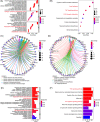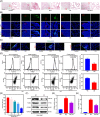Osthole regulates N6-methyladenosine-modified TGM2 to inhibit the progression of rheumatoid arthritis and associated interstitial lung disease
- PMID: 36845072
- PMCID: PMC9945862
- DOI: 10.1002/mco2.219
Osthole regulates N6-methyladenosine-modified TGM2 to inhibit the progression of rheumatoid arthritis and associated interstitial lung disease
Abstract
Rheumatoid arthritis (RA) is an inflammatory autoimmune disease, and RA interstitial lung disease (ILD) is a severe complication of RA. This investigation aims to determine the effect and underlying mechanism of osthole (OS), which could be extracted from Cnidium, Angelica, and Citrus plants and evaluate the role of transglutaminase 2 (TGM2) in RA and RA-ILD. In this work, OS downregulated TGM2 to exert its additive effect with methotrexate and suppress the proliferation, migration, and invasion of RA-fibroblast-like synoviocytes (FLS) by attenuating NF-κB signaling, resulting in the suppression of RA progression. Interestingly, WTAP-mediated N6-methyladenosine modification of TGM2 and Myc-mediated WTAP transcription cooperatively contributed to the formation of a TGM2/Myc/WTAP-positive feedback loop through upregulating NF-κB signaling. Moreover, OS could downregulate the activation of the TGM2/Myc/WTAP-positive feedback circuit. Furthermore, OS restrained the proliferation and polarization of M2 macrophages to inhibit the aggregation of lung interstitial CD11b+ macrophages, and the effectiveness and non-toxicity of OS in suppressing RA and RA-ILD progression were verified in vivo. Finally, bioinformatics analyses validated the importance and the clinical significance of the OS-regulated molecular network. Taken together, our work emphasized OS as an effective drug candidate and TGM2 as a promising target for RA and RA-ILD treatment.
Keywords: TGM2; interstitial lung disease; osthole; rheumatoid arthritis.
© 2023 The Authors. MedComm published by Sichuan International Medical Exchange & Promotion Association (SCIMEA) and John Wiley & Sons Australia, Ltd.
Conflict of interest statement
The authors declare no competing interest.
Figures








Similar articles
-
N6-methyladenosine modification of TGM2 mRNA contributes to the inhibitory activity of sarsasapogenin in rheumatoid arthritis fibroblast-like synoviocytes.Phytomedicine. 2022 Jan;95:153871. doi: 10.1016/j.phymed.2021.153871. Epub 2021 Nov 30. Phytomedicine. 2022. PMID: 34902811
-
Artemisitene suppresses rheumatoid arthritis progression via modulating METTL3-mediated N6-methyladenosine modification of ICAM2 mRNA in fibroblast-like synoviocytes.Clin Transl Med. 2022 Dec;12(12):e1148. doi: 10.1002/ctm2.1148. Clin Transl Med. 2022. PMID: 36536495 Free PMC article.
-
A novel function of artesunate on inhibiting migration and invasion of fibroblast-like synoviocytes from rheumatoid arthritis patients.Arthritis Res Ther. 2019 Jun 24;21(1):153. doi: 10.1186/s13075-019-1935-6. Arthritis Res Ther. 2019. PMID: 31234900 Free PMC article.
-
Incidence, risk factors, and prognosis of acute exacerbation of rheumatoid arthritis-associated interstitial lung disease: a systematic review and meta-analysis.BMC Pulm Med. 2023 Jul 11;23(1):255. doi: 10.1186/s12890-023-02532-2. BMC Pulm Med. 2023. PMID: 37434169 Free PMC article.
-
Methotrexate-Associated Pneumonitis and Rheumatoid Arthritis-Interstitial Lung Disease: Current Concepts for the Diagnosis and Treatment.Front Med (Lausanne). 2019 Oct 23;6:238. doi: 10.3389/fmed.2019.00238. eCollection 2019. Front Med (Lausanne). 2019. PMID: 31709258 Free PMC article. Review.
Cited by
-
Therapeutic potential of natural coumarins in autoimmune diseases with underlying mechanisms.Front Immunol. 2024 Oct 31;15:1432846. doi: 10.3389/fimmu.2024.1432846. eCollection 2024. Front Immunol. 2024. PMID: 39544933 Free PMC article.
-
Advances of the small molecule drugs regulating fibroblast-like synovial proliferation for rheumatoid arthritis.Front Pharmacol. 2023 Jul 21;14:1230293. doi: 10.3389/fphar.2023.1230293. eCollection 2023. Front Pharmacol. 2023. PMID: 37547337 Free PMC article. Review.
-
Sesamolin serves as an MYH14 inhibitor to sensitize endometrial cancer to chemotherapy and endocrine therapy via suppressing MYH9/GSK3β/β-catenin signaling.Cell Mol Biol Lett. 2024 May 2;29(1):63. doi: 10.1186/s11658-024-00583-9. Cell Mol Biol Lett. 2024. PMID: 38698330 Free PMC article.
-
Osthole: A Coumarin with Dual Roles in Biology and Chemistry.Biology (Basel). 2025 May 22;14(6):588. doi: 10.3390/biology14060588. Biology (Basel). 2025. PMID: 40563840 Free PMC article. Review.
-
Etiology and Pathogenesis of Rheumatoid Arthritis-Interstitial Lung Disease.Int J Mol Sci. 2023 Sep 25;24(19):14509. doi: 10.3390/ijms241914509. Int J Mol Sci. 2023. PMID: 37833957 Free PMC article. Review.
References
-
- Daraghmeh DN, King C, Wiese MD. A review of liquid biopsy as a tool to assess epigenetic, cfDNA and miRNA variability as methotrexate response predictors in patients with rheumatoid arthritis. Pharmacol Res. 2021;173:105887. - PubMed
-
- Wang W, Zhou H, Liu L. Side effects of methotrexate therapy for rheumatoid arthritis: a systematic review. Eur J Med Chem. 2018;158:502‐516. - PubMed
-
- Lin X, Tao C, Zhang R, Zhang M, Wang Q, Chen J. N6‐methyladenosine modification of TGM2 mRNA contributes to the inhibitory activity of sarsasapogenin in rheumatoid arthritis fibroblast‐like synoviocytes. Phytomedicine. 2022;95:153871. - PubMed
LinkOut - more resources
Full Text Sources
Research Materials
Miscellaneous
